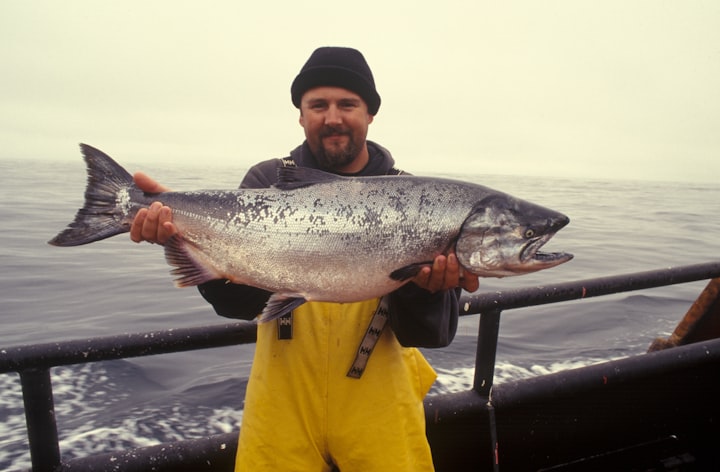How Farm Raised Frankenfish Attack Wild Salmon and Environment Hooked by False Marketing
“From the toxic drugs and chemicals used in fish farming, to its environmental impact on wild fish and the false and misleading marketing claims used by multinational fish farm companies, there are plenty of reasons to avoid farmed fish.” Dr. Joseph Mercola
One of my fondest memories is catching salmon in the Pacific Ocean in younger days. A small live herring is hooked through its back, lowered into the dark water to be a delicious snack for a passing salmon. Once caught, the sudden flight away, the spin reel whirring, the run-and-pull minutes to gradually tire out its strength to survive, and finally lifting up the beautiful silver scaled fish.
Back home the fresh salmon would be cleaned, cut into steaks and fried in butter or barbecued. In my opinion, there is no better flavorful healthy food being rich in Omega 3 fatty acids, a great source of protein with Vitamin B and potassium.
How about yourself? Do you consider fish as a healthier alternative to meat due to the so-called “benefits” on human health and the environment?
But do you know that “healthier” depends on what kind of fish you’re eating and where it’s sourced from?
Three real fish facts that are not fishy
ONE: Farm-raised salmon makes up 75% of the salmon consumed worldwide, and its volume has increased nearly 1,000% from 1990 to 2015 that means an increasing amount of fish on the market (estimated 50%) in restaurants and grocery stores is sourced from large-scale industrial fish farms.
TWO : Your label may say “all natural” but Atlantic salmon probably comes from a massive factory fish farm that may not be anywhere near the Atlantic. Many popular smoked Atlantic salmon brands lure in consumers with misleading claims such as “all natural,” “healthy and nutritious” or “sustainably sourced.”
THREE: The number of fish farms have skyrocketed 527% from 1990 to 2018, because more people are eating fish even while the wild fish stocks are depleted due to overfishing. These massive fish farms of this scale require a lot of capital, which is why most salmon farms are owned by large multinational companies.
Why is an industrial factory fish farm an oddity of Nature?
Fish farms are open-net pens or massive tanks in the open ocean where hundreds of millions of fish are raised. Many ocean fish farms are hidden from the public eye because the pens may be placed up to 164 feet beneath the surface of the water. If out of sight; perhaps, out of mind, nothing to worry about.
Fish are fed a toxic cocktail of pharmaceutical drugs, pesticides and even genetically engineered crops such as soy. Massive amounts of fish waste pollute the environment as well as threaten already vulnerable wild fish with disease.
Fish farms are often described as CAFOs (concentrated animal feeding operations) of the sea that pump water from rivers into their hatcheries and then pump it back out to the river once it’s no longer clean.
“A pen with 200,000 fish produces an enormous amount of waste. In nature, animal waste is not harmful; in fact it is often beneficial. But large concentrations of it can be destructive. The waste of wild fish swimming around is not harmful, but the waste of hundreds of thousands staying in the same spot is.”
In fact, researchers have found that water is often contaminated with dissolved organic matter (DOM) — a mixture of liquid excrement, food residue and other salmon excretions, along with disinfectants and antibiotics that’s altering entire marine ecosystems.
Health Benefits of Farmed Salmon Versus Wild-Caught Salmon
Healthy salmon has a nutritional profile loaded with vitamins, antioxidants and omega-3 fatty acids, but only healthy if it is wild-caught, meaning it fed on natural organisms from its natural habitat.
Farm raised salmon has more in common with a toxic diet than health.
Their diet is processed, high-fat, high-protein dry pellet feed that can include everything from genetically engineered soybeans and pesticides, to polychlorinated biphenyls (PCBs) and dioxins to antibiotics.
Farmed salmon have less nutrition because of elevated fat content with higher amounts of omega-6 with negative health effects as well as absorbing more toxins and PCB contamination.
How Farmed Salmon Threatens Wild Salmon
Farmed fish lack the genes for basic survival in the wild … smaller size, shorter growth period and less reproductive rate, and, inevitably, they can “spill over” into the wild stock swimming by.
Escaping farmed salmon can crossbreed with wild salmon, expose them to disease or infect them with parasites such as sea lice. These lice eat the salmon’s skin around the head and neck where there are no scales. In fact, lice can completely skin a fish’s head that will then die of exposure.
Fish pens may not be cleaned properly with a build up of mussels and other sea life. Unfortunately, sea lice can run rampant in trapped fish farms and cause a huge financial loss for fish farmers when it’s not unusual to find a quarter of a pen lying on the bottom with skinned heads.
Fear of farmed fish escaping into the wild and threatening wild fish is why fish farming is now banned — and will be phased out by 2025 — in Washington state. At the same time, British Columbia, Canada, will also ban open-net fish farms from the Discovery Islands and transition from all fish farms.
Threats from Misleading Marketing Claims
Fact: Majority of Salmon Eaten in the US Comes from Fish Farms
The U.S. captures nearly one-third of the world’s wild salmon that is exported overseas to Japan and China for processing using cheap labor. Two-thirds of the salmon in the U.S. is imported, mostly from industrial fish farms in Chile, Canada, Norway and processing factories in China.
Some companies that raise farmed fish aren’t exactly truthful about their practices. For example, Mowi USA, the world’s largest producer of “Atlantic salmon” products — whether fresh, frozen or smoked — are made from salmon raised on massive industrial fish farms that, in some cases, are nowhere near the Atlantic Ocean.
How to Tell the Difference between Wild or Farm-Raised Salmon
Wild sockeye salmon is bright red because it has natural astaxanthin content with main health benefits. It could be said to be more muscular with very thin fat marks or white stripes. If the fish is pale pink with wide creamy fat marks, the salmon is farmed.
Also look for “Alaskan salmon” and “sockeye salmon” because Alaskan sockeye is not allowed to be farmed.
Fish is an important part of a heathy diet but eat naturally healthy wild-caught Alaskan salmon, sardines, anchovies, mackerel and herring. They are high in healthy omega-3 fats with a lower risk of contamination. Look for fisheries that follow sustainable fishing practices to minimize environmental impacts.
Many of these facts are shocking to me. Did you learn something new or are you more curious about this mass industrialization of our food supply behind closed doors or hidden deep in the ocean? Definitely, more due diligence is required by searching the numerous articles and reports before shopping and enjoying a delicious healthy salmon dinner.
Annemarie Berukoff

About the Creator
Annemarie Berukoff
Experience begets Wisdom: teacher / author 4 e-books / activist re education, family, social media, ecology re eco-fiction, cultural values. Big Picture Lessons are best ways to learn re no missing details. HelpfulMindstreamforChanges.com







Comments
There are no comments for this story
Be the first to respond and start the conversation.